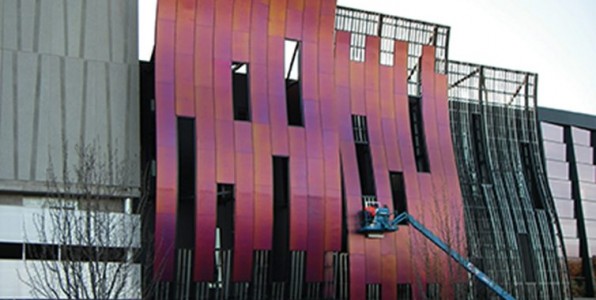The Fascinating World of Metal Facades

The Fascinating World of Metal Facades
The post The Fascinating World of Metal Facades appeared first on UK Construction Blog.
When it comes to architectural design, facades serve as the outward expression of a building’s identity, capturing the attention of passersby and setting the tone for the spaces within.
Among the myriad of facade materials available to architects, various types of metal facades have emerged as versatile and enduring choices, offering a spectrum of options to suit a wide range of aesthetic preferences, functional requirements, and contextual considerations.
Stainless Steel
Stainless steel facades exude timeless sophistication, characterised by their sleek, reflective surfaces and crisp, minimalist detailing.
Renowned for their durability and resistance to corrosion, stainless steel panels are a popular choice for high-end residential, commercial, and institutional projects seeking to make a bold architectural statement while ensuring long-term performance. These items are generally in high-demand in the space of metal fabrication and often the first choice for builders and architects.
While polished or brushed finish stainless steel is the most common way to present a facade, coloured applications are also possible with stainless steel (see photo).

Stainless steel is a particularly attractive choice for designers and developers as it is typically the most cost effective option compared to copper, zinc and aluminium while still retaining the hard-wearing properties and long lifespan.
Copper
Copper facades embrace the rich patina of age, evolving over time to develop a warm, earthy hue that adds character and charm to any building.
Prized for its natural beauty and inherent antimicrobial properties, copper panels are often used in heritage conservation projects, contemporary residences, and cultural institutions seeking to establish a harmonious dialogue with their surroundings. Understandably, copper panels are quite expensive and typically cost significantly more than stainless steel, aluminium or zinc panels.
From the verdant green of weathered copper to the fiery orange of freshly installed panels, these facades celebrate the passage of time and the enduring legacy of craftsmanship.
A recent example of the excellent use of copper cladding is on the Bendigo Law Courts in Victoria, Australia, completed in 2023, which utilised a significant amount of copper cladding to achieve a truly unique finish.

The building’s architect noted that “copper references several of Bendigo’s heritage buildings, is environmentally friendly, fully recyclable, and safe to use. Besides its high corrosion resistance and attractive appearance, it keeps growths such as moss and lichens to a minimum.â€�
Aluminium
Aluminium facades offer architects unparalleled versatility, with a range of finishes, textures, and colours to suit virtually any design concept.
Lightweight yet durable, aluminium panels can be extruded, stamped, or perforated to create custom patterns and motifs that infuse facades with visual interest and architectural character.
For this reason, aluminium facades are great when it comes to creating facade shades or secondary facades (over glazing) to allow the ingress of light while still providing sun protection.
Whether it’s the industrial edge of raw aluminium or the vibrant hues of powder-coated finishes, these facades are prized for their adaptability, affordability, and ease of installation, making them a popular choice for projects of all scales and typologies.
Zinc
Zinc facades epitomise contemporary sophistication, blending the cool elegance of metallic finishes with the warmth of natural materials. prized for its malleability and self-healing properties, zinc panels can be shaped, folded, and manipulated to create sculptural forms and dynamic geometries that defy convention. They may also come in various finishes such as natural (bright), pre-weathered or pigmented.
Zinc panels are popularly installed as a standing seam roof or facade material and can be applied to many different design forms. As a standing seam roofing / facade material, zinc is an ideal choice of material for architects, designers and home-owners alike, particularly because it repels corrosion and combines durability with flexibility, making it easy to install.

LIke any other metal facade, depending on the application, the substrate build-up will be an important factor to consider when thinking about waterproofing and thermal properties.
Whether it’s the lustrous sheen of pre-weathered zinc or the subtle texture of patinated surfaces, these facades exude a sense of modernity and innovation that resonates with avant-garde design sensibilities.
Titanium
Titanium facades represent the pinnacle of material innovation, harnessing the strength, and lightness of this exotic metal to push the boundaries of architectural expression. prized for its exceptional strength-to-weight ratio and resistance to corrosion, titanium panels enable architects to create bold, futuristic forms that defy gravity and capture the imagination.
Because of its ease of processing and relatively high plasticity, titanium (typically alloyed with zinc for cladding) can be used in complex architectural projects, for both roof or facade construction and/or building refurbishment where high strength and durability, as well as visual impact performance are required.
As an example of its hard-wearing properties, there are examples of titanium-zinc roofs, produced over 100 years ago, which do not have any particular maintenance problems, barring colour variations.

Whether it’s the shimmering iridescence of anodized titanium or the high-tech allure of titanium dioxide coatings, these facades embody the spirit of exploration and experimentation that defines the vanguard of contemporary architecture.
Conclusion
Metal facades offer architects a diverse palette of possibilities to realise their design visions, from classic elegance to cutting-edge innovation.
From the sophistication of stainless steel, the warm patina of copper, the versatility of aluminium, the modernity of zinc, or the innovation of titanium, each metal brings its unique characteristics and aesthetic appeal to the built environment.
As architects continue to push the boundaries of creativity and sustainability, metal facades will undoubtedly remain a cornerstone of architectural expression, shaping the skylines of cities around the world for generations to come.

Comments are closed